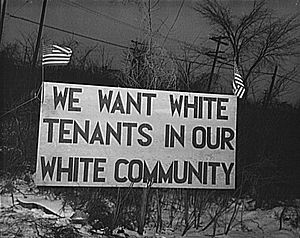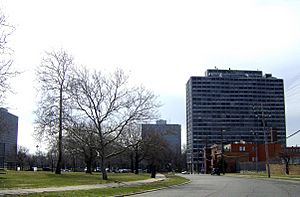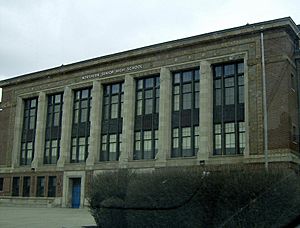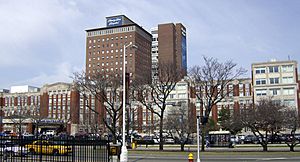1967 Detroit riot facts for kids
Quick facts for kids The Detroit Riot of 1967 |
|||
|---|---|---|---|
| Part of the Long, hot summer of 1967 | |||
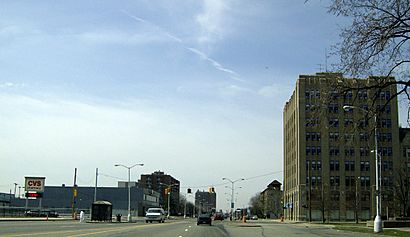
The intersection of West Grand Boulevard at 12th Street in 2008, forty one years after the riot.
|
|||
| Date | July 23–28, 1967 | ||
| Location |
42°22′35″N 83°05′58″W / 42.37639°N 83.09944°W ACoordinates: Extra unexpected parameters |
||
| Caused by | Police raid of an unlicensed, after-hours bar. | ||
| Methods | Rioting, protests, looting, arson, murder, assault | ||
| Resulted in | See Effects | ||
| Parties to the civil conflict | |||
|
|||
| Casualties | |||
|
|||
|
|
|||
The 1967 Detroit Riot, also known as the 12th Street Riot or Detroit Rebellion, was a major event in Detroit, Michigan. It was one of the biggest and most damaging urban riots in American history. It started on Sunday, July 23, 1967, and lasted for five days. The riot mainly involved conflicts between black residents and the Detroit Police Department.
The trouble began when police raided an unlicensed club, sometimes called a "blind pig," on 12th Street. This raid quickly led to widespread rioting, looting, and fires. The riot was much larger than Detroit's 1943 Detroit race riot that happened 24 years earlier.
Michigan's Governor, George Romney, called in the Michigan Army National Guard to help. President Lyndon B. Johnson also sent in the United States Army's 82nd and 101st Airborne divisions. By the end, 43 people had died, 1,189 were hurt, and over 7,200 people were arrested. More than 400 buildings were destroyed.
This riot was the worst in the United States since the 1863 New York City draft riots during the American Civil War. It was not until the 1992 Los Angeles riots 25 years later that a riot caused more damage. News channels, newspapers, and magazines like Time and Life covered the event widely. The Detroit Free Press even won a Pulitzer Prize for its reporting.
The Canadian folk singer Gordon Lightfoot wrote a song called "Black Day in July" about these events. It was released in 1968 and was banned by radio stations in 30 American states.
Contents
- Why the Riot Happened: Understanding the Background
- The Riot Begins: Key Events
- Impact and Changes
- What People Think Now: The Legacy
- In Popular Culture
- Art Inspired by the Riots
- See also
Why the Riot Happened: Understanding the Background
Racial Segregation and Housing Issues
In the early 1900s, many African Americans moved to Detroit during the Great Migration. The city grew very fast, but there wasn't enough housing. African Americans faced a lot of unfair treatment when trying to find homes. Rules and agreements among white people kept black people out of certain neighborhoods. This made it hard for most African Americans to buy their own homes.
A system called "redlining" also made it almost impossible for black Detroiters to buy homes in many parts of the city. This forced black residents into older, lower-quality neighborhoods. These unfair practices led to a lot of anger and tension in the city before the riot. Segregation also meant that police often treated African American neighborhoods more harshly, which added to the frustration.
Even in the mid-1900s, racial separation continued. For example, in 1956, the mayor of Dearborn, Michigan, a city near Detroit, openly said that black people could not live there.
Changes and Continued Problems
When Jerome P. Cavanagh became Mayor in 1961, he tried to make some changes to the police department. Detroit also received money from the government to help poor areas. By the 1960s, many black people had better jobs and there was a growing black middle class. The city had black leaders in government and schools.
However, many black Detroiters, especially those who were poor, still felt frustrated. They faced unfair treatment in housing and from the police. Rosa Parks, who moved to Detroit, said in 1964 that housing segregation was still a big problem, even in larger cities. Despite some improvements, unfair treatment by police and racial tension were still very strong in Detroit in the 1960s. These issues played a big part in causing the riot.
Police and Community Relations
The Detroit Police Department was directly managed by the Mayor. Before the riot, there were efforts to improve the police force. They tried to hire more black police officers. However, they did not create a special board for citizens to complain about police, which African Americans had asked for. This made many police officers unhappy. Many white people also thought the police were being "too soft on crime."
A study found that before the riot, many police officers working in black neighborhoods held strong negative views about black people. In 1967, most of the police force (93%) was white, even though 30% of the city's residents were black. Black residents felt police treated them badly, using disrespectful language. Police often stopped and searched groups of young black men. They also arrested people who didn't have proper identification.
There were many news reports about police shootings and beatings of black citizens before 1967. After the riot, a survey showed that police brutality was the number one problem for residents leading up to the riot. Black citizens also felt that police responded slower to their calls than to calls from white citizens. They also believed some police officers were involved in illegal activities in black neighborhoods.
Police raids on after-hours drinking clubs, called "blind pigs," were also a source of anger. These clubs had been important social places for black citizens since the 1920s. They continued because many regular bars and restaurants in Detroit did not serve black people.
Jobs and Money Problems
After World War II, Detroit lost almost 150,000 jobs as factories moved to the suburbs. This was due to new technology, more machines doing work, and changes in the car industry. Many big companies closed down. In the 1950s, the number of people without jobs was around 10 percent.
Between 1946 and 1956, car companies spent billions on new factories, but almost all of them were built outside Detroit. This meant workers had to leave the city to find jobs. Many middle-class families also moved to newer homes in the suburbs. Detroit's population dropped a lot between 1950 and 1970, which hurt businesses and city services.
By the time of the riot, unemployment for black men in Detroit was more than double that for white men. Black workers often had less "seniority" (time on the job) in factories. This meant they were the first to be laid off when jobs were cut after the war. Also, black workers often got the hardest, most dangerous, and unhealthiest jobs.
Even when the car industry grew again in the early 1960s, black workers still got the "worst and most dangerous jobs." Many black citizens who didn't work in factories had jobs as waiters, porters, or janitors. Many black women could only find work as domestic helpers. Some businesses were known for not hiring black workers, even for entry-level jobs.
Housing Development and Discrimination
Housing was a big problem in Detroit because of the fast growth of industries. After World War II, several city projects aimed at improving housing actually changed neighborhoods a lot. These projects often affected black people the most, as they lived in some of the oldest homes.
Racial discrimination in housing was even supported by the government through "redlining" and other rules. These rules made it hard for black people to get loans for homes. Almost all neighborhoods with black residents were given a low rating, which made it nearly impossible for them to buy houses outside these areas or fix their homes. Only a tiny percentage of new homes were available to African Americans.
Neighborhoods like Black Bottom and Paradise Valley became mostly African-American because of these rules. The city wanted to stop businesses from leaving downtown and improve housing. But these projects often destroyed older neighborhoods, forcing black people to move to other crowded areas, like the 12th Street neighborhood.
The 12th Street area quickly changed from being mostly Jewish to mostly black. Many black residents rented from landlords who didn't live in the area. Crime rates also went up in the 12th Street area. By 1967, white and black people were often separated, leading to high racial tension. After the riot, a survey showed that poor housing was the second biggest issue leading to the riot, after police brutality.
Education Challenges
Detroit Public Schools faced money problems and unfair treatment based on race before the riots. As the city's population dropped, less tax money was available for schools, even though the number of students grew. Schools in the inner city, mostly black, had less funding per student compared to suburban schools.
Class sizes in inner-city schools were often too large, sometimes with 40 students per teacher. Black groups worked to improve education for black students. They worried about class sizes, school boundaries, and how white teachers treated black students. A committee found unfair treatment in hiring teachers and principals.
In 1966, students at Detroit Northern High School, which was 98% black, protested. They said teachers didn't challenge black students enough. Students walked out and set up their own "Freedom School." This protest made headlines and showed the deep problems in the school system.
Retail Stores and Services
Surveys showed that black customers were very unhappy with how store owners treated them. In stores in black neighborhoods, owners often used unfair credit practices and were rude to customers. Civil rights groups tried to address these issues with the city government before the riot.
A survey after the riot found that people in inner-city areas paid 20% more for food than those in the suburbs. This was partly because suburban stores were larger and had easier delivery. After the riot, Mayor Cavanagh criticized businesses for charging too much and asked for laws to stop unfair pricing.
The Riot Begins: Key Events
The riot involved looting, fires, and shooting. It happened in many parts of Detroit, especially on the west side of Woodward Avenue and around 12th Street. The entire city was affected from Sunday, July 23, to Thursday, July 27.
July 23: The Start
Police Raid and Crowd Gathers
Early on Sunday, July 23, 1967, around 3:45 a.m., Detroit police raided an unlicensed club on 12th Street. They expected only a few people, but found 82 people celebrating the return of two soldiers from the Vietnam War. Police decided to arrest everyone. While they waited for transport, a large crowd gathered outside. A doorman later said he started the riot by throwing a bottle at a police officer.
Looting Begins
After the police left, the crowd started to loot a nearby clothing store. Soon, widespread looting began in the neighborhood. The Michigan State Police and Michigan Army National Guard were called, but it took hours to get enough officers. Witnesses described a "carnival atmosphere" on 12th Street. Police did not make their first arrest until 7 a.m., three hours after the raid. The first major fire started in a grocery store that afternoon. The crowd stopped firefighters from putting it out, and soon smoke filled the sky.
City's Response
Local news at first avoided reporting on the riot to prevent it from spreading. But the violence grew, and looting started in other parts of the city. People at events like a Motown show and a baseball game were warned to avoid certain areas. Motown singer Martha Reeves even told her audience to leave quietly because of the trouble. Detroit Tigers player Willie Horton drove to the riot area in his uniform and tried to calm the crowd, but they did not listen.
Mayor Jerome Cavanagh said the situation was "critical" but not "out of control." He set a citywide curfew from 9:00 p.m. to 5:30 a.m. and banned alcohol and gun sales. Many nearby towns also set curfews. White people also took part in the rioting and looting.
July 24: Spreading Chaos
More Police and Arrests
The Michigan State Police and local sheriff's department were called in to help the overwhelmed Detroit police. As the violence spread, police made many arrests, putting people in temporary jails. People were held without being formally charged right away. Police took pictures of arrested looters, the officer, and the stolen goods to speed things up. Most of those arrested (over 80%) were black, and about 12% were women.
Political Disagreements
Michigan Governor George Romney and President Lyndon B. Johnson disagreed about sending in federal troops. President Johnson said he couldn't send troops unless Governor Romney declared a "state of insurrection." This decision was complicated by politics, as Romney was expected to run for president. Mayor Cavanagh also had disagreements with Governor Romney.
Violence Increases
Violence grew throughout Monday. There were 483 fires, and 1,800 arrests. Looting and fires were widespread. Even businesses owned by black people were damaged. Firefighters trying to put out fires were shot at. Thousands of guns were stolen from local stores. It became clear that local and state forces could not control the situation.
John Conyers' Plea
On Monday, U.S. Representative John Conyers tried to calm things down. He drove along 12th Street with a loudspeaker, asking people to go home. He even stood on his car and shouted, "We're with you! But, please! This is not the way to do things!" But the crowd threw rocks and bottles at his car.
July 25: Military Steps In
Federal Troops Arrive
Just before midnight on Monday, July 24, President Johnson allowed federal troops to be used. This was a big step, making Detroit the only U.S. city to have federal troops sent in three times. About 8,000 Michigan Army National Guardsmen were deployed. Later, 4,700 paratroopers from the 82nd and 101st Airborne Divisions, and 360 Michigan State Police officers joined them.
The police were overworked and tired. Some Detroit police officers were found to have treated prisoners badly, both black and white. Many injuries happened after people were arrested.
Even though only a few arrests were for sniping, the fear of snipers led to many police searches of homes and cars. Breaking curfew also led to police brutality.
Tragic Death of Tanya Blanding
A four-year-old girl named Tanya Blanding was tragically killed during the riot. She was in her apartment near 12th Street. Guardsmen reported being shot at from her building. A National Guard tank moved into position, and when someone in the apartment lit a cigarette, Guardsmen fired into the apartment. Tanya Blanding died at 1:20 a.m. Her mother later filed a lawsuit, but the Guardsman was cleared.
July 26: Restoring Order
Controlling the Violence
Some people believe the violence got worse when troops arrived, but they did bring the rioting under control within 48 hours. Most of the Michigan Army National Guard were white and not used to city situations. The Army paratroopers, however, were racially mixed and had experience from Vietnam. They were better at handling the situation. Only one person killed by troops was shot by a federal soldier. The Army paratroopers were told not to load their weapons unless an officer ordered it. A report later criticized the National Guardsmen for shooting and killing nine civilians.
Tanks and machine guns were used to restore peace. Pictures and videos shown around the world showed a city on fire, with tanks and soldiers fighting in the streets.
Help from Relief Groups
Amidst the chaos, people also helped each other. Churches, unions, and businesses worked together to provide food, clothing, and shelter to those in need. This help was given to everyone, no matter their race or religion. White reporters trapped in dangerous areas were sometimes taken into black homes for safety, even though it was risky for the families.
July 27–28: Troops Leave
By Thursday, July 27, order was mostly restored. National Guardsmen had their ammunition taken away and were told to put away their bayonets. Troops started leaving on Friday, July 28, the day of the last big fire. All Army troops were gone by Saturday, July 29.
Impact and Changes
Widespread Unrest
The Detroit riot caused unrest in other places. Minor rioting happened in nearby suburbs. National Guardsmen or state police were sent to other Michigan cities like Pontiac, Flint, and Grand Rapids, as well as cities in Ohio and New York. Disturbances were reported in more than two dozen cities.
Local Views on the Riot
Black and white people in Detroit saw the riot very differently. Surveys after the riot showed that white people were more likely to support separation of races. Only 1% of black Detroiters wanted "total separation," while 17% of white Detroiters did. Most African Americans (88%) supported "integration," but only 24% of whites did.
Damage and Losses
About 10,000 people took part in the riots, and 100,000 watched. In 36 hours, 43 people died (33 black, 10 white). More than 7,200 people were arrested, mostly black. Mayor Jerome Cavanagh said, "Today we stand amidst the ashes of our hopes."
The riot caused huge damage. 1,189 people were hurt, including civilians, police, firefighters, and soldiers. 7,231 people were arrested, some as young as 4 and as old as 82. Many had no criminal record. Most arrests were for looting or breaking curfew.
Over 2,500 businesses were looted or damaged. 388 families lost their homes. 412 buildings were burned or damaged so badly they had to be torn down. The total cost of property damage was between $40 million and $45 million.
Joe's Record Shop
Joe's Record Shop on 12th Street, owned by Joe Von Battle, was one of the businesses destroyed. It was a famous shop where artists like John Lee Hooker and Aretha Franklin recorded music. During the riot, Battle tried to guard his shop, but police stopped business owners from doing so. When he returned, his shop and all its recordings were ruined. He could not reopen.
Deaths
A total of 43 people died. Most were black (33), and 10 were white. Many black deaths were caused by police officers or National Guardsmen. Some were killed by store owners or security guards. Others died from fires or accidents. One black teenager was killed by Army paratroopers.
Among the white deaths were civilians, firefighters, a looter, a police officer, and a Guardsman. Two firefighters died, one from electrocution and one from a gunshot. One police officer was shot by looters. One Guardsman was shot by fellow Guardsmen by mistake.
Political and Economic Changes
The riot made many white residents leave Detroit even faster. From 1967 to 1969, 173,000 white people left. Detroit public schools lost 74% of their white students between 1967 and 1978.
After 1967, the black community in Detroit received more attention from the government. Money flowed into black-owned businesses. Coleman Young, Detroit's first black mayor, said the riot hurt the city's economy greatly. Businesses and white people left, taking jobs, money, and taxes with them.
Riot Control Strategies
The riot showed the military and government that they needed plans for controlling unrest in American cities. It confirmed the role of the Army in dealing with such situations.
Hiring More Minorities
After the riot, state and local governments hired many more minority workers. In 1967, the State Police hired its first black trooper. By 1972, black people made up 14% of the Detroit police force, more than double the number in 1967. The government also pushed companies with state contracts to hire more nonwhite employees.
Businesses also lowered their hiring requirements. One supervisor said that before, businesses tried to keep people out, but now they tried to find reasons to hire them.
New Housing Laws
Before the riot, Detroit had no laws to end housing segregation. After the riot, Governor Romney pushed for new housing laws, including fair housing rules. Even though there was resistance, these laws passed. The Michigan Fair Housing Act, which started in 1968, was one of the strongest in the country. This showed that the riot helped bring about important changes in housing.
STRESS Police Unit
Two years after the riot, a special police unit called STRESS (Stop the Robberies, Enjoy Safe Streets) was created. Many white Detroiters saw it as a way to control crime. However, STRESS mainly focused on black communities and led to more conflicts between police and black residents.
This unit was accused of raiding homes without warrants and killing 20 people in 30 months. This caused a lot of fear and hatred. Community groups protested and demanded STRESS be ended.
Coleman Young, who later became Detroit's first black mayor, strongly opposed STRESS. He said it was an "execution squad" and promised to get rid of it if elected. When Young became mayor, he ended STRESS. This helped bring more black people into the police department and changed the relationship between the police and the black community.
African-American Progress
The riot showed problems in the system, and steps were taken to fix them. In 1970, First Independence National Bank helped African Americans get loans, which was hard before due to redlining. This helped people improve their lives.
Organizations like HOPE were founded to fight hunger and unfairness at work. They also provided job training for young people. Other groups helped African Americans get college educations or have a voice in the workplace.
The biggest change was that African Americans gained more political power in Detroit. For the first time, they could influence city policies. Mayor Coleman Young made changes to the police and fire departments to make them more diverse. He also got money from President Jimmy Carter for education and housing. In 1972, Erma Henderson became the first African American president of the Detroit Common Council, fighting against discrimination.
What People Think Now: The Legacy
Public Opinion Today
A 2016 survey asked people in the Detroit area about race relations since the riots. People in Detroit were more hopeful about race relations than the national average. More than half of white and black Detroiters thought race relations were good. They also believed things would improve in the future.
However, there are still challenges. When asked what word they would use for the 1967 events, most white people said "riot," while black people were more likely to say "rebellion" or "uprising." Many black Detroiters still feel they face unfair treatment in jobs, like hiring or promotions.
How the Event is Described
Forty years later, the event is still a topic of discussion. News articles often called it a "riot," but some people preferred the term "rebellion." This shows different ways of understanding what happened.
In Popular Culture
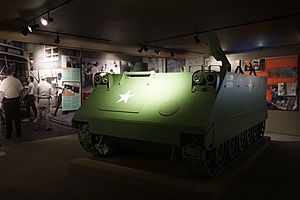
Many songs mention the riot. These include "Black Day in July" by Gordon Lightfoot, "The Motor City Is Burning" by John Lee Hooker, and "Panic in Detroit" by David Bowie. Other songs like "Ball of Confusion" by The Temptations and "Ghetto Child" by The Spinners also refer to the events.
An episode of Star Trek: The Original Series used footage of burning buildings from the riot to show a war on another planet.
The 1970 novel Iggie's House by Judy Blume mentions the riot. The main character accidentally offends new neighbors from Detroit by asking if they looted during the riot.
The riots were also shown in movies like Dreamgirls, Across the Universe, and Detroit. The TV show Detroit 1-8-7 used old footage and photos from the riots in a 2010 episode.
The novels Middlesex by Jeffrey Eugenides and them by Joyce Carol Oates also feature the riot. The 2017 film Detroit is based on a true event during the riots called the Algiers Motel incident.
Art Inspired by the Riots
Visual Art
Many artworks were created because of the 1967 events. The "Art of Rebellion: Black Art of the Civil Rights Movement" exhibit at the Detroit Institute of Arts featured some of these. Black Attack (1967) by Allie McGhee shows the strength of black people during this time.
In 2017, Rita Dickerson created 1967: Death in the Algiers Motel and Beyond. This artwork shows the Algiers Motel and portraits of three young black men killed by police there. It also lists names of people who died in recent police encounters, showing that police brutality continues.
Written Art
Bill Harris, a poet and educator from Detroit, wrote about the black community in Detroit after July 1967 in his book Detroit: a young guide to the city.
Performing Arts
In 2017, two plays based on real stories were performed. Detroit '67 shared memories from five Detroiters. AFTER/LIFE showed the events from the viewpoints of women and girls.
|
See also
 In Spanish: Disturbios de Detroit de 1967 para niños
In Spanish: Disturbios de Detroit de 1967 para niños


